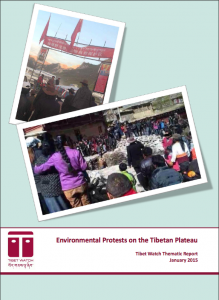Tibet Watch publishes report on Environmental Protest
DHARAMSHALA: “China’s vision of development and hunger for economic growth are both powerful driving forces and the environmental exploitation of Tibet shows no sign of slowing down”, said a new report titled “Environmental Protest on the Tibetan plateau” released by Britain based Tibet Watch, a human rights group.
The report finds creative responses by Tibetans to the challenges of opposing China’s policies in Tibet but a consistent failure by authorities to address their grievances and the frequent use of force to suppress protest.
The report examined 12 confirmed protests across Tibet’s three regions, U-Tsang, Amdo, and Kham. “Mining is the most common trigger for demonstrations, with damming and river pollution also provoking opposition. Tibet’s rich natural resources include fresh drinking water and large-scale mineral deposits, such as gold, copper, silver, chromium and lithium. The rivers running off the Tibetan plateau are ideal for the generation of hydropower,” it said.
Speaking in an interview with Tibet Watch, a Tibetan mentioned, “Tibetans do not learn the value of the earth through science but through our religion and the way our ancestors protected our land over thousands of years. They saved the land for the next generation to enjoy as pure land, the beauty o f nature and to have a clean and peaceful environment to live in. Therefore destruction of the land, the mining of sacred mountains and holy lakes, are more than pollution and destruction of the environment. It is a violation of our tradition, religious beliefs and the destruction of our forefathers’ legacy.”
According to the report, despite consistent protests by the Tibetans, China shows no sign of slowing down the exploitation and addressing the grievances of the Tibetan protesters. Although a handful of protests have been met with assurances of action, these have rarely led to positive outcomes.
The report also mentioned that many Tibetans have committed suicide in protest against the environmental exploitation and at least two self-immolations have taken place near mining sites in Amchok Township on November 2012. Tsering Dhondup, 34, a father to three children and Kunchok Tsering, 18, set themselves on fire and died.
“But the deep bond between the Tibetans and their land is equally strong and environmental protests are likely to continue, and likely to continue evolving, as long as China continues to ignore the people and the environment of the Tibetan plateau,” it said.
Source: www.tibet.net



comment 0